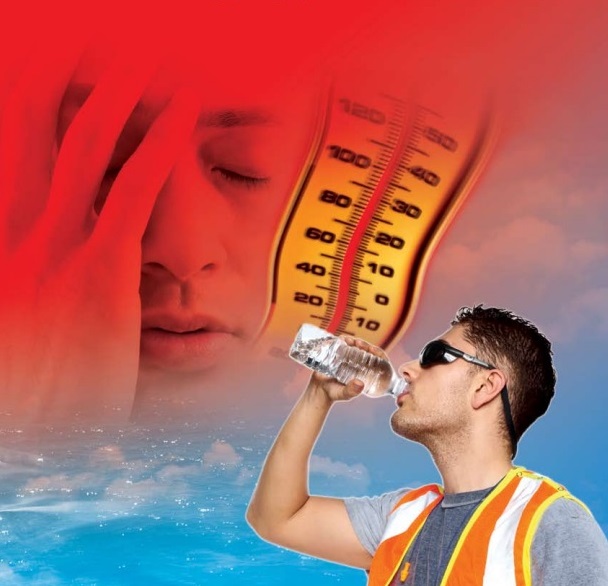
Free resources: Download and share safety talk, presenter guide, hazard alert
Beat the Heat Safety Talk Presentation
Beat the Heat Safety Talk Leader Guide
Hazard Alert: Heat stress can be a killer
Heat-related illnesses are cause for concern, and with summer almost here, it’s time for a refresher on the best ways to beat the heat at work. Keep in mind that severe heat-related illnesses like heat exhaustion can occur for several days after dehydration from exposure to high temperatures, according to the Canadian Centre for Occupational Health and Safety, whether you work outdoors as a tree planter, inside a mill, or toil year-round in toasty places like bakeries, foundries, or underground mines.
Top 10 warning signs of heat stroke
Symptoms of heat stress can range from mild heat rash or sunburn to severe heat exhaustion and heat stroke.
- Extremely high body temperature
- Hot, dry, skin – an inability to cool the body through perspiration may cause the skin to feel dry
- Increased heart and respiration rates as blood pressure drops and the heart attempts to maintain adequate circulation
- Throbbing headache, nausea or vomiting due to dehydration
- Weakness, fainting, or dizziness – especially if standing position is assumed quickly – due to low blood pressure from dehydration
- Muscle cramps
- Dark-coloured urine – a sign of dehydration
- Confused, hostile, or seemingly intoxicated behaviour
- Pale or bluish skin colour in advanced cases due to constricted blood vessels
- Seizures or unconsciousness
What to do if you suspect heat exhaustion or stroke
- Get medical aid
- Move to air-conditioned environment or at least a cool, shaded area
- Loosen or remove unnecessary clothing
- Drink plenty of cool water
- Fan and spray with cool water
How to protect yourself against heat stress
Sometimes it’s difficult to self-recognize heat stress, so it’s important to use a buddy system at work to keep an eye on each other and spot potential heat stress symptoms.
- Stay fit
- When possible, avoid working in hot areas and in full sun
- Take frequent breaks
- Use sunblock with at least SPF 15 and re-apply every two hours
- Cover up with long-sleeve shirt, hat
- Increase fluid intake
- Avoid alcohol and excessive caffeine
- Reduce activity when exposed to heat
- Use buddy system to watch for symptoms
- Increase salt intake (if doctor approves)
How employers can protect workers against heat stress
- Train workers in heat stress awareness and first aid
- Provide drinking water
- Provide rest breaks and air conditioned rest areas
- Post urine colour chart in washrooms to raise awareness about hydration
- Encourage workers to stay fit; to drink water
- Indoors, provide fans for air movement
- Use machines to reduce physical demands of work
- Schedule most strenuous work to cooler times of the day
- Measure daily Humidex ratings and have a Humidex Heat Stress Response Plan
- Have a heat stress prevention program specific to your workplace – see pages 8-11 of the Heat Stress Awareness Guide for a sample heat stress policy
Related
How to avoid heat stress for masked workers
Napo in ... Heat Stress (Walk the Talk) - European Agency for Safety and Health at Work
Napo in… Heat stress (The duel) - European Agency for Safety and Health at Work
For more information, contact Workplace Safety North or contact your local WSN Health and Safety Specialist.
Free Resources
Free heat stress prevention resources - Workplace Safety North
Heat Safety Tool App real-time guidance for your specific location - OSHA-NIOSH
Mine Rescue Heat Stress Report and Standard - Ontario Mine Rescue
Managing and preventing heat stress in the workplace - Health and safety conference presentation
Heat at Work - Guidance for Workplaces - European Agency for Safety and Health at Work
Heat stress guideline – Ontario Ministry of Labour, Training and Skills Development
Heat stress vs. heat stroke comparison poster
Humidex Calculator - Occupational Health Clinic for Ontario Workers
Working in the Heat infographic - Canadian Centre for Occupational Health and Safety (CCOHS)
Sun Safety at Work: A Management Systems Approach to Occupational Sun Safety - School of Occupational Health, Ryerson University
Sun safety in Canada infographic - CCOHS
